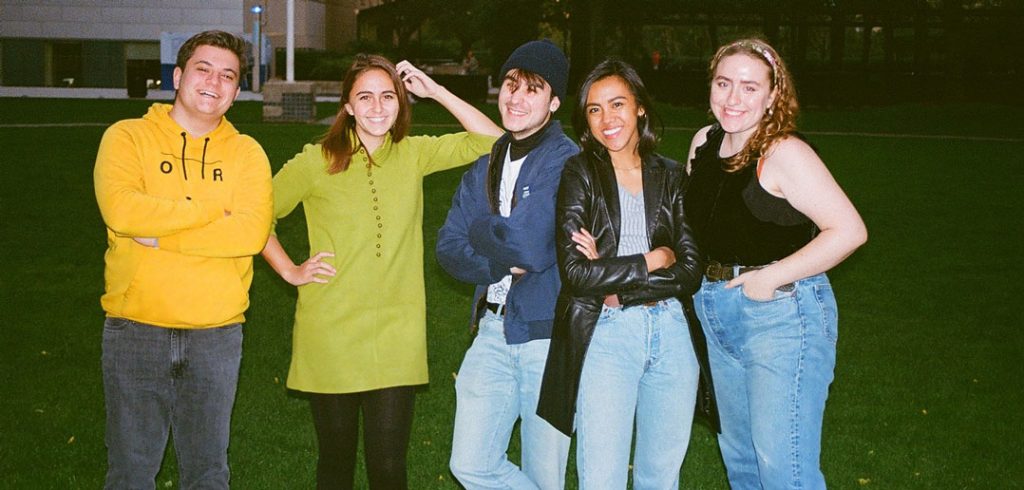That was a thought that crossed Alyssa Morales’ mind during the summer following her first year at Fordham. Morales had applied for internship opportunities to work in radio that year, but never heard back. That’s when she decided to take matters into her own hands.
Now a sophomore and president of the club, Morales said, “Honestly, I just posted on Instagram, and I said, ‘Hey, if anyone is interested in starting a student-run radio station at Lincoln Center, let me know.’”
FCLC sophomores Duncan Taylor (vice president), Sean de Ganon (secretary), Caitlin Bury (treasurer), and Gillian Kwok (graphic design and art director), all answered her post and eventually became part of the executive board of the student-run radio project, which they named “Wavelengths.”
“I reached out to Alyssa when I saw her post, because I also wanted to do something kind of like that,” Taylor said. “WFUV’s at Rose HIll, but (radio) was kind of lacking at Lincoln Center, there really wasn’t any sort of opportunity for us.”
The group spent the fall semester applying to be an official student-run club while testing out their internet radio idea at the same time.
“We decided to borrow tech equipment and audio equipment from The Observer, and every Sunday we would have a set,” Morales said. “Sometimes we would have a theme, sometimes we would just be playing songs that we’ve been listening to, and we would just be playing for about an hour.”
Because they weren’t an official club at first, the first few months were definitely a challenge, Morales said. The group had to bounce to different sites that would host their broadcast each week, meaning their URL also changed each time. To keep their listeners, they posted their links through their Instagram page to get people to tune in and then put together playlists on Spotify to reach those who missed the live broadcast.
“It was kind of like a do-it-yourself project while we were trying to become a club. We had to figure out how to fundraise for the broadcasting service, because that costs money, and we also tried to do other things in terms of fundraising just to really make ends meet,” she said.
Something “eventually stuck” in the spring semester, Morales said, and they were officially approved as a student club.
Just a few weeks later, however, Fordham would close its on-campus operations due to the coronavirus outbreak, leaving the students trying to reimagine their project once again.
“We’ve been grinding for the past two months which has been excellent and the break has been difficult, but it also I think has given us a second to step back and ask ourselves what we really want this to be,” Kwok said.
One of the things they decided to do, the students said, was launch a permanent website, which includes album reviews, artist spotlights, opinion articles, and weekly DJ song picks.
They’re also working to expand their audience using social media platforms and student involvement.
“We’re trying to incorporate a general interest in music, so whether that would be people writing about it, people sharing their own music, whatever we can—we’re just trying to do that through the website,” Bury said. “Gill is working on a lot of graphics to up our social media game—we do have an Instagram, so hopefully we’ll get more active on Instagram and maybe even go on Twitter or Facebook too.”
Keith Eldredge, assistant vice president and dean of students at Lincoln Center, complimented the students for seeing an opening and working to start their own project.
“I think it’s pretty exciting when students would show that type of passion” he said.
While the future of Wavelengths is up to the students, Eldredge said that University departments, such as communications and media studies, would be interested in potential partnerships.
Kwok said she could see Wavelengths turning into a “creative hub” at Lincoln Center for musicians and other artists alike.
“I think we noticed that at Fordham Lincoln Center, there’s a general appreciation for music and we saw the opportunity to fill this gap for people who love music,” she said. “In our community, (there’s) lots of artistic people. We recognize that and want to create a hub, I think, for people to be able to cultivate that.”
So far, the students said that Wavelengths has helped them grow and understand their love and passion for music in ways they might not have expected.
“Growing up, I was very much into music,” Morales said. “I was singing my whole life, played the piano, guitar, all that, and I didn’t really realize how much music was a part of my life until I started doing this.”

